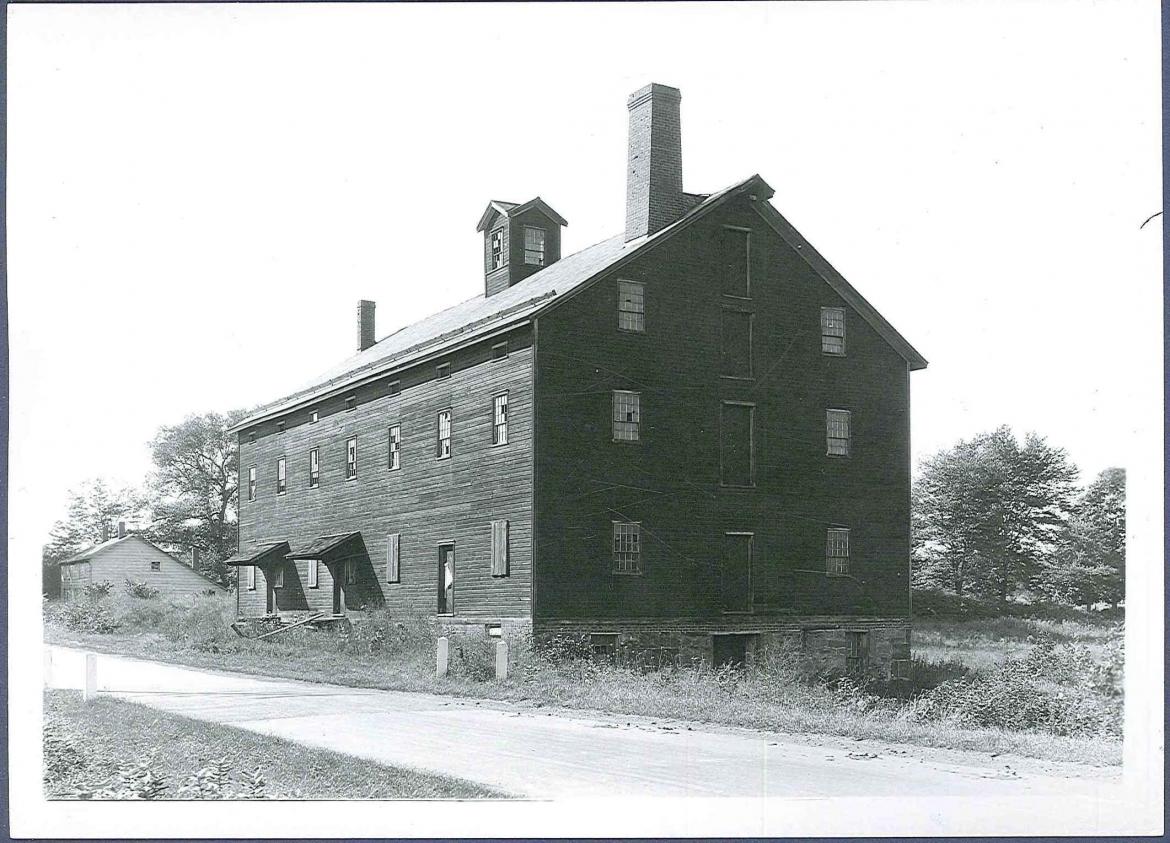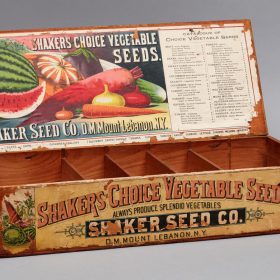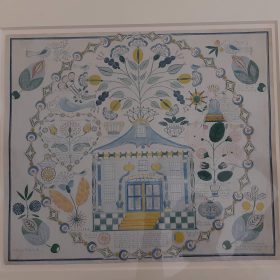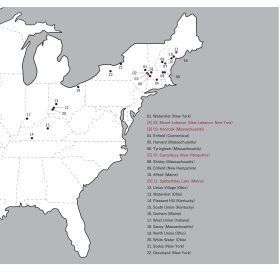図1 WatervlietのSawmill
調査の目的
シェーカーは労働を生活の中心に据え、製材所や製粉所を利用して様々なものを制作していた。シェーカー教の労働に対する考え方や、コミュニティ内で利用されていた製材所の外観、使用道具、教徒たちの利用方法について調べることで、彼らの教義理念と労働がどのように結びついていたのかを明らかにすることが目的である。
本文該当部分
「彼らはあなたをどこかへやるのですか?」
「そうはしないと思います。彼らは小川の上流に新しくできる製材所で私に手伝うように言っていますから」(第18章より)
(“Are they going to send you away?”
“I think not. They say I am to help with the new sawmill they are building up the creek.”)
製材所はとても儲けの多い事業だった。(第22章より)
(The sawmill was a highly profitable enterprise.)
シェーカーにとっての労働
シェーカーは全員、何らかの仕事につくことが定められている。マザー・アンが説いた “Give your hands to work and your hearts to God”(あなたの手を仕事に、あなたの心を神に捧げなさい)という言葉にも現れているように、シェーカー教にとって労働は、日常的にも精神的にも非常に大きな比重を占める活動である。シェーカーがなぜ労働を重要視していたのかについて、Art of Shakerにはこのような記述が見られる。
They believed that labor worked a positive influence on individuals, in part by keeping them too busy to think about physical needs. In a practical sense, the prosperity of each village depended on the labor of all capable hands for the well-being of the entire community. (Julie Nicoletta『The Architecture of the Shakers』p107. より
彼らは、労働が個人に良い影響を与えると信じていた。それは、肉体的な必要性について考える余裕がないほど忙しいということでもある。つまり、村の繁栄のためには、有能な人たちの労働力が必要であり、それが村全体の幸福につながると考えていたのだ。
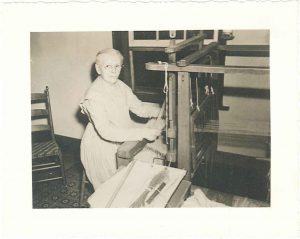 図2 労働するシェーカー
図2 労働するシェーカー
シェーカーは働くことを生活の核としていたため、部外者に労働を任せた結果として衰退したことを指摘するような意見も存在している。下記の引用はThe Architecture of the Shakersからのものである。このことから、シェーカーの労働倫理は共同体の活動そのものを支えていたことがわかる。
As the Shakers grew to rely more on hired help, they lost hold of this work ethic. Often hired help and their families lived with the Shakers, bringing their worldly ways into the community and in direct contact with the brothers and sisters. Furthermore, as the majority of Shakers grew older, they became accustomed to working less and relying more on the labor provided by hired hands. This dependence on people of the world no doubt contributed to the decline of Shakerism in the late nineteenth century by de-emphasizing the significance of work as part of the Shaker religion. (Julie Nicoletta『The Architecture of the Shakers』p.108 より
シェイカーが雇われた人に頼るようになると、この労働倫理が失われていった。多くの場合、雇われた人やその家族はシェイカーたちと一緒に暮らし、彼らの世俗的な考え方をコミュニティに持ち込み、兄弟姉妹と直接接していた。さらに、シェイカーの多くは年齢を重ねるにつれ、仕事を減らして雇い人の提供する労働力に頼ることに慣れていった。このような世間の人々への依存は、19世紀後半のシェイカー教の衰退の一因となり、シェイカー教における労働の重要性が薄れていったのは間違いない。
シェーカーの製材所について
シェーカー教には様々なMill(製作所)があり、その中でも素材を加工する場所はSawmill(製材所)と呼ばれていた。製材所はシェーカーが労働をする上で重要な施設である。彼らは製材所で木材を切り出し、加工することで、建築や発明品など、彼らの生活の根底をなすものの基盤となる素材を作り出していた。製材所については、The Architecture of the Shakersにこのような記述がある。
Like the grist mills, Shaker saw mills provided the means to process lumber for the Shakers’ own building and carpentry projects as well as bringing in money from nearby non-Shakers who needed lumber sawn. Every village had at least one saw mill; larger villages often had more. Until the late nineteenth century, the Shakers brought timber from their own forests as far away as Michigan, and sawed and planed it in their own mills. Without the capacity to produce their own building lumber, the Shakers would have had to spend more money on the many ongoing construction projects for dwellings, shops, and other buildings. The number and type of workshop could vary greatly from one village to another. (Julie Nicoletta『The Architecture of the Shakers』p.107 より)
シェイカーの製材所は、製粉所と同様に、シェイカー教徒の建築や大工仕事に必要な木材を加工する手段として、また製材を必要とする近隣のシェイカー教徒以外の人々から資金を得る手段として利用されていた。どの村にも少なくとも1つの製材所があり、大きな村ではさらに多くの製材所があった。19世紀後半まで、シェーカー教徒は遠くミシガン州の森林から木材を運び、自分たちの製材所でそれを製材し、鉋で削っていた。建築用の木材を自前で生産する能力がなければ、シェーカー教徒は住居や店舗などの建築物を継続的に建設するために、より多くの費用をかけなければならなかっただろう。製材所の数や種類は、村によって大きく異なっていた。
 図3 Union Villageのmill
図3 Union Villageのmill
製材所で使われていた道具
製材所では様々な道具が使われていた。シェーカーが発明したと言われている丸鋸なども製材所で使用される道具の一つであったとして知られている。労働の効率化を目指すシェーカーは、製材所で使用する道具の発明にも積極的であった。
・丸鋸
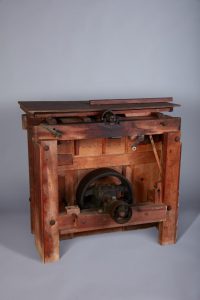 図4 シェーカーの丸鋸
図4 シェーカーの丸鋸
Shaker modified circular table saw, water powered. The table top, to which a fence is attached, is removable. Underneath this top is another top with a T-square bevel. This original top was hinged to bench on the right side. Hinges were removed to accommodate two devices to raise and lower front of the table. In the rear, there is yet a later added mechanism for finer adjustments to table raising. (Shaker Museumより)
シェーカーによって改造された、水力で動く丸鋸。囲いが付いている天板は取り外し可能である。この天板の下には、T定規の斜角が付いた別の天板がある。このオリジナルの天板は、右側のベンチにヒンジで固定されていた。机の前面を上下させる2つの機械に対応するために、ヒンジが取り外された。後部には、机の位置を微調整するための仕掛けが後で追加されている。
・鋸
 図5 シェーカーの鋸
図5 シェーカーの鋸
Cast steel blade and back, open handle of beech. Two copper rivets and burrs secure handle to clade. Blade is tapered. (Shaker Museumより
鋳鋼で造られた刃、ブナ製のオープンハンドル。 2つの銅製リベットとバリが、ハンドルをクレードに固定している。刃は先細った形になっている。
・剪定鋸
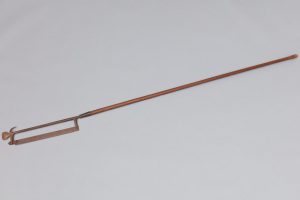 図6 シェーカーの剪定鋸
図6 シェーカーの剪定鋸
Iron head fashioned with chisel blade at end, a hook on one side and two prongs on other into which a saw blade is set (pinned at lower end and bolted at upper end). (Shaker Museumより
端にチゼルブレード、片側にフック、もう一方に鋸刃がセットされた2本のプロング(下端にピン留めされ、上端にボルトで固定されている)で作られた鉄製の頭部分。
・鉋
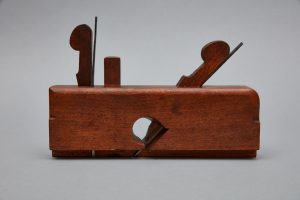 図7 シェーカーの鉋
図7 シェーカーの鉋
Plane body of beech; depth stop, knicker wedge and iron wedge of maple. One slanting blade and one straight up blade in the front. (Shaker Museumより)
ブナによって造られた土台、カエデ製のデプス・ストップ、ニッカーウェッジ、アイアンウェッジ。鋼正面に傾斜刃1枚と直立刃1枚があり、 「Stothert、Bath、D.R.6 / 8」と刻印されている。
さまざまなmill
シェーカーにはSawmill(製材所)以外にも様々なMill(製作所)がある。粉をひくためのGrist millや、衣服を製作するためのClothier’ mill、水を汲み上げるためのPump millなどがその代表例である。シェーカーはそれぞれのMillを用途ごとに使い分けていた。
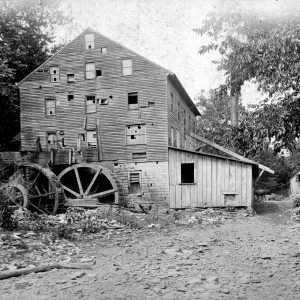 図8 Grist Mill, PleasantHill (1952)
図8 Grist Mill, PleasantHill (1952)
 図9 Grist Mill, Hancock, 年代不詳
図9 Grist Mill, Hancock, 年代不詳
まとめ
効率的な労働のために発明や建築を造り続けるシェーカー教の姿勢には、労働を重視し、生活の中心に据えるスタイルが影響しているということがわかった。また、建築や発明品を自分たちで製作するシェーカー教の特性上、製材所は金銭的な問題を補助するような役割を担っていたことも明らかになった。用途によって建物を分けるシェーカーのやり方は、彼らがいかに効率的な労働方法を日々探っていたかを象徴するようなものであると言えるだろう。
執筆:高塚
参考文献
David R. Starbuck『The Shaker Mills in Canterbury, New Hampshire』, Journal of the Society for Industrial Archeology
Vol. 12, No. 1 (1986), pp. 11-38 (28 pages)
Scott T. Swank『Shaker Life, Art, and Architecture』Abbeville Press, 1999
Stephen Paterwic『Historical Dictioonary of the Shakers』 Rowman & Littlefi eld Publishers, 2017
Priscilla J. Brewer『 Shaker Communities, Shaker Lives』Univ Pr of New England; Reprint edition, 1988
Shaker Museum (https://www.shakermuseum.us/collection/shaker-dress-plain-comfortable-economical-comely/practicality/)
最終閲覧 2021/07/23
図版出典
図1 Shaker Museum (https://www.shakermuseum.us/object/?id=18634&limit=24&offset=0&sort=name_ref&q=working)
図2 Shaker Museum (https://www.shakermuseum.us/object/?id=18634&limit=24&offset=0&sort=name_ref&q=working)
図3 Shaker Museum (https://www.shakermuseum.us/object/?id=18634&limit=24&offset=0&sort=name_ref&q=working)
図4 Shaker Museum (https://www.shakermuseum.us/object/?id=18634&limit=24&offset=0&sort=name_ref&q=working)
図5 Shaker Museum (https://www.shakermuseum.us/object/?id=18634&limit=24&offset=0&sort=name_ref&q=working)
図6 Shaker Museum (https://www.shakermuseum.us/object/?id=18634&limit=24&offset=0&sort=name_ref&q=working)
図7 Shaker Museum (https://www.shakermuseum.us/object/?id=18634&limit=24&offset=0&sort=name_ref&q=working)
図8 Shaker Museum (https://www.shakermuseum.us/object/?id=18634&limit=24&offset=0&sort=name_ref&q=working)
図9 Shaker Museum (https://www.shakermuseum.us/object/?id=18634&limit=24&offset=0&sort=name_ref&q=working)

